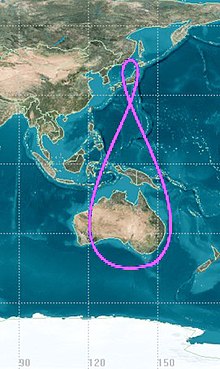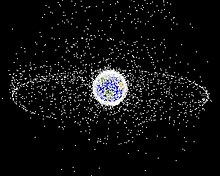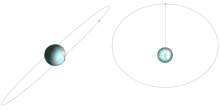Geosynchronous orbit
Over the course of a day, the object's position in the sky may remain still or trace out a path, typically in a figure-8 form, whose precise characteristics depend on the orbit's inclination and eccentricity.British science fiction author Arthur C. Clarke popularised and expanded the concept in a 1945 paper entitled Extra-Terrestrial Relays – Can Rocket Stations Give Worldwide Radio Coverage?, published in Wireless World magazine.[15] Although these projects had difficulties with signal strength and tracking that could be solved through geosynchronous satellites, the concept was seen as impractical, so Hughes often withheld funds and support.Although its inclined orbit still required moving antennas, it was able to relay TV transmissions, and allowed for US President John F. Kennedy to phone Nigerian prime minister Abubakar Tafawa Balewa from a ship on August 23, 1963.[26] Each satellite dwells over Japan, allowing signals to reach receivers in urban canyons then passes quickly over Australia.[28][30] Once in a viable geostationary orbit, spacecraft can change their longitudinal position by adjusting their semi-major axis such that the new period is shorter or longer than a sidereal day, in order to effect an apparent "drift" Eastward or Westward, respectively.[34] Geosynchronous satellites require some station-keeping in order to remain in position, and once they run out of thruster fuel and are no longer useful they are moved into a higher graveyard orbit.It is not feasible to deorbit geosynchronous satellites, for to do so would take far more fuel than would be used by slightly elevating the orbit; and atmospheric drag is negligible, giving GSOs lifetimes of thousands of years.[35] The retirement process is becoming increasingly regulated and satellites must have a 90% chance of moving over 200 km above the geostationary belt at end of life.Satellites commonly have an inclination of zero, ensuring that the orbit remains over the equator at all times, making it stationary with respect to latitude from the point of view of a ground observer (and in the ECEF reference frame).In the general case of a geosynchronous orbit with a non-zero inclination or eccentricity, the ground track is a more or less distorted figure-eight, returning to the same places once per sidereal day.





orbital periodEarth's rotationsidereal dayinclinationeccentricitygeostationary orbitequatorial planeCommunications satellitessatellite antennasArthur C. ClarkeHerman Potočnikspace stationsVenus EquilateralGeorge O. Smithscience fictionWireless Worldequatorial orbitHarold RosenHughes AircraftSputnik 1high frequencyundersea cablerocketmediumEcho balloon satellitesTelstar 1spin stabilisedinclined orbitJohn F. KennedyAbubakar Tafawa Balewaremote sensingmicrowavefiber-opticdiurnal motiontelecommunications satellitessolar windradiation pressuregravitationalstation-keepingzenithanalemmaground stationsTundra orbitfrozen orbitstationkeepingSirius XM Satellite RadioQuasi-Zenith Satellite Systemurban canyonsGeostationary transfer orbitEchoStar XVIIinclination changelaunch vehiclesgeosynchronous transfer orbitapogeeperigeestatitesolar sailspace elevatorgraveyard orbiteccentric orbitsEuropean Space AgencyOlympus-1meteoroidExpress-AM11Telkom-1standard gravitational parameterargument of perigeeground trackequatorGeosynchronous satelliteHigh Earth orbitList of orbitsList of satellites in geosynchronous orbitLow Earth orbitMedium Earth orbitMolniya orbitSubsynchronous orbitSupersynchronous orbitSynchronous orbitSmith, George O.Ballantine BooksClarke, Arthur C.Los Angeles TimesBibcodeInternational Telecommunication UnionEUMETSATNASA Institute for Advanced ConceptsorbitsCaptureCircularEllipticalHighly ellipticalEscapeHorseshoeHyperbolic trajectoryInclinedNon-inclinedKeplerLagrange pointOsculatingParabolic trajectoryParkingPrograde / RetrogradeSynchronousTransfer orbitGeocentricGeostationaryGeostationary transferGraveyardHigh EarthLow EarthMedium EarthMolniyaNear-equatorialOrbit of the MoonSun-synchronousTransatmosphericTundraVery low EarthAreocentricAreosynchronousAreostationaryDistant retrogradeLissajousLibrationHeliocentric
